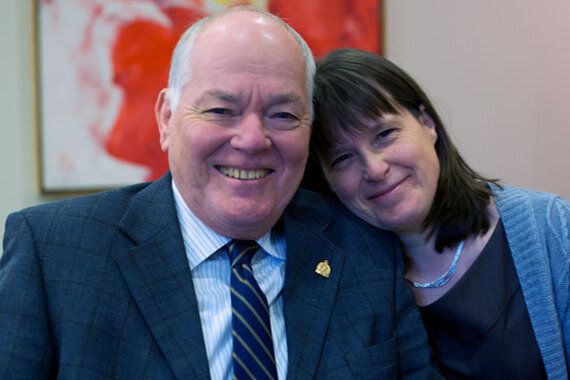
Former RCMP officer Greg Bohaker and daughter Heidi Bohaker. (Photo by Johnny Guatto/University of Toronto)
In 1963 my father was a 21 year old RCMP constable stationed in Hopedale, Labrador, in a two-man detachment responsible for policing a large region from Makkovik in the south to Davis Inlet in the north. In December of that year he developed a flu-like illness and lost weight rapidly. In two short weeks, he lost 35 lbs, a once strapping now gaunt 6'1" officer. In the first week of January he was shipped out for medical evaluation at the RCAF hospital in Goose Bay.
The base doctor thought he had just had a bad flu and recommended he return to work, but before Dad could fly back his condition worsened, and he was sent to see Dr. W. Anthony Paddon at the Grenfell Mission Hospital at North West River (about 30 miles east of Goose Bay). Dr. Paddon (who went on to become the Lieutenant Governor of Newfoundland) immediately realized that my father had actually developed Type 1 diabetes, a complete inability of the body to produce insulin and therefore to metabolize sugar.
This disease was once lethal but thanks to the Nobel prize-winning research conducted at the University of Toronto in 1921-22, diabetes had become a controllable condition through daily injections of insulin derived from cattle and pigs. My father received his first shot of life-saving insulin on Jan 14, 1964, half an hour after arriving at the Mission hospital. After a five-day stay he was then shipped out to hospital in St. John's, Newfoundland where he remained for three weeks before returning to duty. He later married my mother, whom he had met during his time in Hopedale. She was one of two local schoolteachers.
As a child I grew up hearing the remarkable story of the discovery of insulin, and I certainly knew that my own existence was due to the substance in the multiple needles that my father injected every day. On day trips to the Royal Ontario Museum from our home in Oshawa, we invariably walked through U of T's campus as well, past the Medical Sciences Buildings which is the original location of Professor John MacLeod's laboratory, where Dr. Frederick Banting conducted his experiments alongside research assistant Charles Best and biochemist Bertram Collip.
I also heard of course about the importance of U of T's Connaught laboratory which was the first to mass-produce insulin, along with other life-saving medications and vaccines, and which made them available to all at affordable prices. My father did not complete high school before he entered the RCMP, but he certainly impressed upon both my brother and me the importance that basic research at universities contributes to society, and in particular of course research at the University of Toronto.
There was, therefore, extra cause for celebration when I was offered a tenure-stream position in History at the University of Toronto. And I remember phoning my father shortly after my arrival here with the exciting news that the initial research grant awarded to new faculty came from the Connaught fund, an endowment created by the University's sale of the Connaught laboratories in 1971 to the private sector. The discovery and production of insulin was continuing to fund new research.
On January 14th, 2014, I attended a reception held by the President and Provost to congratulate those of us who had achieved tenure in the past year. For me, it was a doubly special day - as the 14th was also the 50th anniversary of my father's diagnosis and first insulin injection.
In the 1960s, insulin saved lives, but my father still knew and expected that his life would be shorter and full of additional medication complications as a result of his disease. We grew up anticipating that my father would be outlived by our grandfather. But years of continued research and refinements in diabetic treatment, and the development of humulin, synthetic human insulin, have significantly changed that original picture. My father, now 71, has recently had cataract surgery, and his knees are a bit arthritic. Not complications of diabetes, but now-welcomed signs of normal aging. And he's very much enjoying his nearly four-year old grandson.
At times of fiscal restraint and focus on applied research with immediate commercial applications, my father's story reminds me about the importance of universities as places that create the space for big "what if" and "I wonder" questions, like the one Dr. Frederick Banting asked, on a hunch, about the cause of diabetes. Basic research sometimes results in dead ends, but sometimes results in the kinds of remarkable discoveries that makes new and different futures possible, including, I am keenly aware, my own!
By Heidi Bohaker, associate professor in the University of Toronto's Department of History.